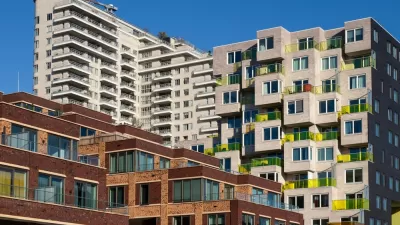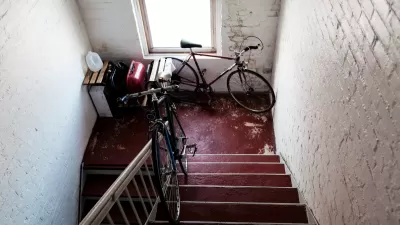Critics of the double-staircase mandate for multi-story buildings argue that it does little to improve fire safety while raising the costs of housing construction and limiting community interaction.

“If a rule to allow new construction to have a single staircase up to six stories is approved, then smaller buildings that better foster community among residents could begin popping up in cities and towns across the commonwealth [of Virginia],” reports Wyatt Gordon for The Virginia Mercury. “Although the United States and Canada lowered the height limit for such construction to three stories nearly a century ago, the rest of the world never allowed fears of fires to hinder such housing.” In fact, many of Virginia’s older buildings were constructed before the double-staircase rule was put into place.
“Modern American building codes mandate double-loaded staircases if a building exceeds three stories, inevitably leading developers to build the big, bland 5-over-1s” and forcing buildings to take up more real estate. “Efforts to present fire experts with the facts on single staircase structures are already underway giving advocates hope that fire officials’ support can be secured before DHCD comes to a final decision later this year,” notes Gordon.
Proponents of single-staircase buildings point to several advantages. “Instead of the long, dark corridors demanded by double-loaded staircases, single staircase buildings create community through their compactness.” Additionally, “When there is no cavernous hallway going straight through the middle of the building apartments can stretch from one side of the building to the other, enabling cross ventilation and sunlight on both sides of the unit.”
Like parking minimums and other building code requirements, the double-staircase mandate can have a powerful impact on housing affordability and construction costs. “Increased living space and lower construction costs translate to more affordable rents without any state subsidy required,” making it easier for private developers to build more affordable housing.
FULL STORY: How allowing single-staircase buildings could change Virginia’s housing market

Manufactured Crisis: Losing the Nation’s Largest Source of Unsubsidized Affordable Housing
Manufactured housing communities have long been an affordable housing option for millions of people living in the U.S., but that affordability is disappearing rapidly. How did we get here?

Americans May Be Stuck — But Why?
Americans are moving a lot less than they once did, and that is a problem. While Yoni Applebaum, in his highly-publicized article Stuck, gets the reasons badly wrong, it's still important to ask: why are we moving so much less than before?

Using Old Oil and Gas Wells for Green Energy Storage
Penn State researchers have found that repurposing abandoned oil and gas wells for geothermal-assisted compressed-air energy storage can boost efficiency, reduce environmental risks, and support clean energy and job transitions.

Updating LA’s Tree Rules Could Bring More Shade to Underserved Neighborhoods
A new USC study finds that relaxing Los Angeles’ outdated tree planting guidelines could significantly expand urban tree canopy and reduce shade disparities in lower-income neighborhoods, though infrastructure investments are also needed.

California's Canal Solar Projects Aim to Conserve Resources and Expand Clean Energy
California’s Project Nexus has begun generating electricity from solar panels installed over irrigation canals, with researchers and state agencies exploring statewide expansion to conserve water and boost clean energy production.

HHS Staff Cuts Gut Energy Assistance Program
The full staff of a federal program that distributes heating and cooling assistance for low-income families was laid off, jeopardizing the program’s operations.
Urban Design for Planners 1: Software Tools
This six-course series explores essential urban design concepts using open source software and equips planners with the tools they need to participate fully in the urban design process.
Planning for Universal Design
Learn the tools for implementing Universal Design in planning regulations.
Heyer Gruel & Associates PA
City of Moreno Valley
Institute for Housing and Urban Development Studies (IHS)
City of Grandview
Harvard GSD Executive Education
Salt Lake City
NYU Wagner Graduate School of Public Service
City of Cambridge, Maryland





























